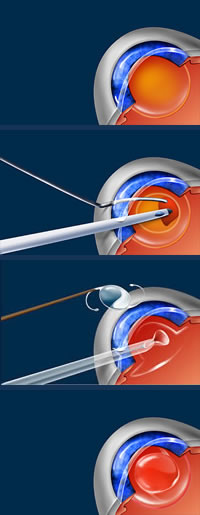Cataract Surgery Center
The eye has a normally clear lens that is located just behind the pupil. A cataract occurs when the natural lens in the eye becomes cloudy. The lens is responsible for focusing light on the retina. When a cataract is present the amount of light that reaches the retina is diminished. As the cataract develops and grows, less and less light reaches the retina which causes the vision to become worse. Depending on the size of the cataract, the clouding effect may have either a small or great impact on the vision.
Cataracts are typically related to aging but there are also other kinds of cataracts. Congenital cataracts are present at birth. An injury to the head or the eye may cause a traumatic cataract. Secondary cataracts may be the results of another eye disease or medications such as steroids.
A patient may have a cataract in each eye but the cataract may develop at different paces. A cataract often is very slow in developing and the brain has time to process the reduction in vision. Some patients may not even be aware that they suffer from a cataract. On the other hand, some patients have a noticeable cataract and cannot see well enough to perform tasks that they would like to do.
Currently the only treatment option available for a cataract is surgery. Surgery only becomes necessary once the cataract starts to interfere with normal daily activities. There is no way to eliminate a cataract once it has developed in the eye, once the cataract has become developed enough it will require surgery. Your eye doctor will determine when surgery is best for you. The surgery is performed as an outpatient procedure. Many patients will notice immediate results following their cataract removal.
Modern day cataract surgery is done by a procedure called phacoemulsification. The center of the lens is softened by ultrasound waves until a small incision can be made. Then the small needle-like device goes in and breaks apart the cataract. The same needle is used to vacuum out the cataract from the eye. The incision made is so small that no stitches are required. After the cataract is removed a lens implant is usually put into place. The surgeons at Great Maryland Eye Physicians will discuss your options with you. We participate with Medicare for glasses following cataract surgery.
We invite you to visit Greater Maryland Eye Physicians and Surgeons located in Clinton Maryland. Please feel free to fill out our appointment form and we will contact you directly.

When a cataract is removed, it is replaced with an artificial intraocular lens (IOL).
There are a variety of IOLs that can be used in cataract surgery, and they each have their own set of advantages and disadvantages. No single IOL works best for everyone, and only your ophthalmologist can determine the most appropriate IOL for your needs.

Age-related macular degeneration is a chronic eye disease marked by deterioration of tissue in the part of your eye that's responsible for central vision. The deterioration occurs in the macula which is in the center of the retina — the layer of tissue on the inside back wall of your eyeball.
Diabetic retinopathy is the most common diabetic eye disease and a leading cause of blindness in American adults. It is caused by changes in the blood vessels of the retina.
The retina is the light-sensitive tissue at the back of the eye. A healthy retina is necessary for good vision. If you have diabetic retinopathy, at first you may not notice changes to your vision. But over time, diabetic retinopathy can get worse and cause vision loss. Diabetic retinopathy usually affects both eyes.

